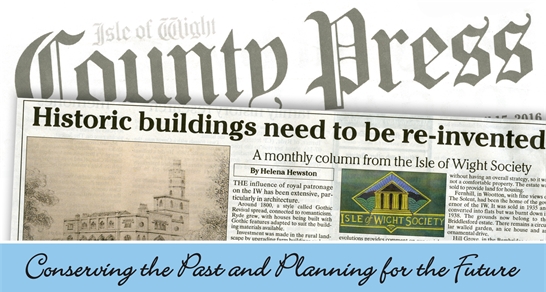Historic buildings need to be re-invented
The influence of royal patronage on the Isle of Wight has been extensive, particularly in
architecture. Around 1800 a style called Gothic Revival spread, connected to romanticism. Ryde
grew, with houses being built with Gothic features adapted to suit the building materials available.
Investment was made in the rural landscape by upgrading farm buildings and creating large houses
set in extensive grounds. New technology gave rise to ice houses and entrance lodges, heating
systems and bathrooms. The building boom gave impetus to planning control, but it was relatively
easy to demolish what was deemed unsatisfactory and undesirable. Osborne House was built on
the site of a country house. The manorial lands changed into “estates”. The word “castle” helped
show off the aspirations of the owners.
Several properties in the Gothic Revival Style graced the landscape. Farringford is a good example.
In the mid-1900s the Island lost several similar buildings, not necessarily Victorian in origin. Their
demise and evolutions provides comment on our social history and culture. Two that are very well
known are Appuldurcombe and East Cowes Castle.
Appuldurcombe had been a manorial seat for the Worsley family boasting 18th century Baroque
elegance. The gardens were sculptured by Capability Brown. In its latter days it had been a school
and might have been re-invented if WWII had not intervened and damage followed by neglect left
it with the shell, now partly re-roofed.
East Cowes Castle suffered the same fate in 1963. The war-time damage came from lack of respect
by the troops billeted there followed by subsequent neglect. It, too, was a late 18th century
creation, home of John Nash. He built and then added to it without having an overall strategy, so
internally it was not a comfortable property. The estate was sold to provide land for housing in
East Cowes.
Fernhill in Wootton, with fine views of the Solent, had been the home of the Governor of the Isle
of Wight. It was sold in 1935 and converted into flats but was burnt down in 1938. The grounds
now belong to the Briddlesford estate. There remains a circular walled garden, an ice house and
an ornamental drive.
Hill Grove in the Bembridge area disappeared in the 1960s when it was allowed to become derelict.
The site is used as a camping holiday park at St Helens. St. Clare Castle at Appley succumbed to
fire in 1960. Steephill Castle in Ventnor was built on the site of a cottage and was a castellated
mansion with sea views. After being the seat of John Hanborough it was used by the Holiday
Fellowship for a time and then became a school after which it closed and was demolished in 1963.
The stable and clock tower remain.
The cost of restoring these examples of Gothic Revival architecture was prohibitive. The Island has
lost some interesting structures. Several period buildings are under threat today. Let’s hope
investors can find some ways of reinventing the use of the buildings while still retaining their
architectural merit.
[Go Back]

